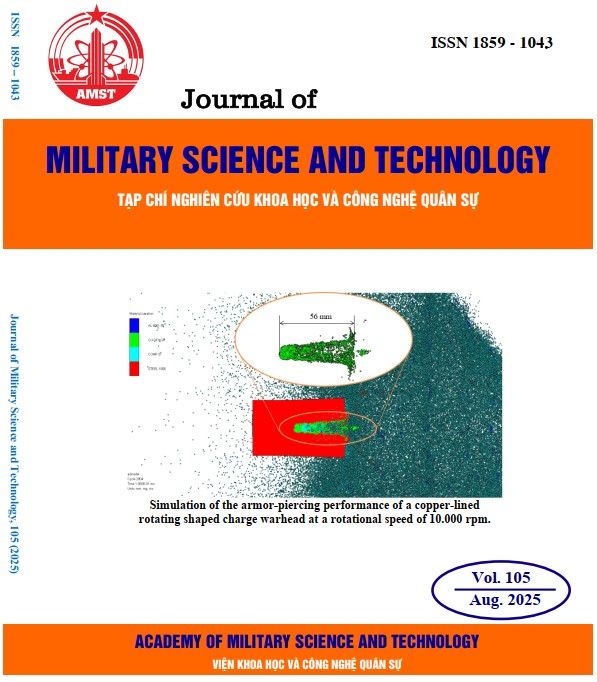Tổng hợp khối tạo tín hiệu điều khiển hệ truyền động điện cho robot tự hành 2 bánh vi sai sử dụng cơ cấu chấp hành PA-BLDC
297 lượt xemDOI:
https://doi.org/10.54939/1859-1043.j.mst.105.2025.20-27Từ khóa:
Hệ truyền động điện BLDC; Khuếch đại công suất; Robot tự hành; Tạo tín hiệu điều khiển.Tóm tắt
Bài báo nghiên cứu tổng hợp khối tạo tín hiệu điều khiển cho hệ truyền động điện trong robot tự hành 2 bánh vi sai sử dụng động cơ một chiều không chổi than (Brushless Direct Current - BLDC) đi kèm bộ khuếch đại công suất (Power Amplifier - PA). Đề xuất cấu trúc và mô tả toán học của khối tạo tín hiệu điều khiển đầu vào PA dựa trên phương trình vi phân, đảm bảo hệ điều khiển truyền động bám theo phần tử dẫn đường với độ chính xác cao. Giải tích toán học đã chứng minh hệ thống ổn định và hội tụ đến giá trị mong muốn với sai số bám nhỏ. Mô phỏng được thực hiện trong MATLAB Simulink với các tín hiệu dẫn đường khác nhau biến đổi theo thời gian.
Tài liệu tham khảo
[1]. Le Ba Yen, Le Khanh Thanh, Vu Quoc Huy, “Xe tự hành tích hợp cảm biến dẫn đường quán tính và từ tính”, Vietnam Journal of Science and Technology, No. 8, pp. 40-42, (2022) (in Vietnamese).
[2]. Dang, K.N., Nguyen, V., Vu, H.Q. (2025), “Non-singular Terminal Sliding Mode Control of the Steering Wheels of 4WD4WS Mobile Robot”, Proceedings in Technology Transfer, Springer, Singapore, (2024). doi: 10.1007/978-981-97-7083-0_11. DOI: https://doi.org/10.1007/978-981-97-7083-0_11
[3]. Hari Maghfiroh, F. Adriyanto, Adrian Seta Ekananda, Joko Slamet Saputro, A. Sujono, R. Lullus Lambang GH, “Brushless Direct Current (BLDC) Motor Control System with Isolated Gate Driver”, International Conference on Electrical and Information Technology (IEIT), (2021), doi: 10.1109/IEIT53149.2021.9587442. DOI: https://doi.org/10.1109/IEIT53149.2021.9587442
[4]. Visconti, P., & Primiceri, P., “An overview on state-of-art and future application fields of BLDC motors: design and characterization of a PC-interfaced driving and motion control system”, Journal of Engineering and Applied Sciences, 4913-4926, (2017).
[5]. Damir Krkljes, Ć Morvai, K. Babković, L. Nagy, “BLDC motor driver - Development of control and power electronics”, 27th International Conference on Microelectronics Proceedings, (2010). doi: 10.1109/MIEL.2010.5490467. DOI: https://doi.org/10.1109/MIEL.2010.5490467
[6]. Marimuthu, M. and Rajaiah, J. “An Optimal Control Theory Based Analysis of Brushless DC Motor Drive”, Circuits and Systems, 7, 3384-3391, (2016). doi: 10.4236/cs.2016.710288. DOI: https://doi.org/10.4236/cs.2016.710288
[7]. Md Mahmud, S. M. A. Motakabber, A. H. M. Zahirul Alam and Anis Nurashikin Nordin, “Control BLDC Motor Speed using PID Controller” International Journal of Advanced Computer Science and Applications(IJACSA), 11(3), (2020). doi: 10.14569/IJACSA.2020.0110359 DOI: https://doi.org/10.14569/IJACSA.2020.0110359
[8]. A. Zhilenkov, Denis Denk, “Designing of a sensorless control system for brushless direct current motor”, IEEE Conference of Russian Young Researchers in Electrical and Electronic Engineering, (2017). doi: 10.1109/EICONRUS.2017.7910748. DOI: https://doi.org/10.1109/EIConRus.2017.7910748
[9]. R. Shanmugasundram, K. M. Zakariah, N. Yadaiah, “Low-Cost High-Performance Brushless DC Motor Drive for Speed Control Applications”, International Conference on Advances in Recent Technologies in Communication and Computing, (2009). doi:10.1109/ARTCom.2009.66. DOI: https://doi.org/10.1109/ARTCom.2009.66
[10]. Amol R. Sutar, G. Bhide, J. Mane, “Implementation and study of BLDC motor drive system”, International Journal of Engineering Sciences & Research Technology, (2016). doi: 10.5281/ZENODO.50975.
[11]. J. F. Gieras, “Permanent Magnet Motor Technology: Design and Applications”, 3rd Edition, CRC Press, (2010). DOI: https://doi.org/10.1201/9781420064414
[12]. R. Krishnan, “Electric Motor Drives: Modeling, Analysis, and Control”, Prentice Hall, (2001).
[13]. T. H. Kim and M. E. Elbuluk, “Torque Ripple Reduction of BLDC Motors Using Active Torque Control”, IEEE Transactions on Power Electronics, vol. 20, no. 6, pp. 1313-1320, (2005).
[14]. Y. S. Kung, “Design and Implementation of a High-Performance PMLSM Servo Drive”, IEEE Transactions on Industrial Electronics, vol. 55, no. 3, pp. 1341-1351, (2008). DOI: https://doi.org/10.1109/TIE.2007.909736
[15]. Quoc Huy Vu, “Strict Sliding Mode Control with Power Reaching Law and Disturbance Bounds in Synchronous Servo Tracking Drive System”, International Journal of Electrical and Electronic Engineering & Telecommunications, vol. 12, no. 5, pp. 350-357, (2023). doi: 10.18178/ijeetc 12.5.350-357. DOI: https://doi.org/10.18178/ijeetc.12.5.350-357
[16]. Nguyen Thi Thu Thao, Vu Quoc Huy, “Sliding mode control with exponent sliding surface-reaching law in the tracking drive systems using synchronous servo at torque-position mode”, Journal of Military Science and Technology, no. 80, pp. 31–38, (2022).







